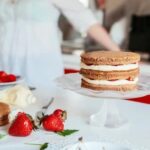What icing do professional cake decorators use? Icing plays a crucial role in the art of cake decorating, determining not only the final appearance but also the taste and texture of the finished product. Professional cake decorators have a range of icing options at their disposal, each with its own unique qualities and uses. In this article, we will explore the different types of icing commonly used by professional cake decorators, including their characteristics and ideal applications.
When it comes to creating stunning and delectable cakes, professional cake decorators rely on various types of icing to achieve their desired results. From buttercream to fondant, royal icing to ganache, each type of icing brings its own set of attributes to the table. Understanding the characteristics and advantages of each can help decorators make informed choices when creating their masterpieces.
Buttercream icing is often considered the go-to choice for professional cake decorators due to its versatility and ease of use. Fondant icing, on the other hand, offers a smooth and professional-looking finish that is ideal for creating intricate designs.
Royal icing is known for its traditional use in piping and creating delicate decorations, while ganache provides a luxurious and stable option for achieving a flawless surface on cakes. Each type of icing has its place in the world of professional cake decorating, offering decorators a range of possibilities for bringing their creative visions to life.
Types of Icing Commonly Used by Professional Cake Decorators
Professional cake decorators have a variety of options when it comes to choosing the right icing for their creations. Each type of icing offers unique benefits and is well-suited for different cake decorating techniques and designs. The most commonly used types of icing by professional cake decorators include buttercream, fondant, royal icing, and ganache.
Buttercream icing is a popular choice among professional cake decorators for its smooth and creamy texture, making it easy to work with and ideal for creating different decorations such as piping, rosettes, and borders. Its versatility also allows for various flavorings and colorings, making it suitable for a wide range of cake designs.
Fondant icing is another go-to choice for professional cake decorators due to its ability to create a smooth and flawless finish on cakes. This versatile type of icing can be rolled out and draped over the cake to achieve sharp edges and clean lines, perfect for more intricate designs such as wedding cakes or sculpted cakes.
Royal icing is known for its traditional use in intricate cake designs, such as creating delicate lacework, intricate piped details, or constructing 3D decorations. Its sturdy texture sets firmly when dried, making it an excellent choice for creating decorations that need to hold their shape.
Lastly, ganache has gained popularity among professional cake decorators for its luxurious taste and stable consistency. This rich blend of chocolate and cream is ideal for creating a smooth glaze or a decadent filling for cakes, as well as providing a firm base for sculpted or tiered cakes.
Understanding the different qualities of each type of icing allows professional cake decorators to make informed choices based on the specific requirements of their designs. Whether it’s achieving smooth finishes with fondant or creating intricate details with royal icing, selecting the right type of icing can make all the difference in bringing a cake design to life.
Buttercream Icing
Advantages of Buttercream Icing
One of the main advantages of using buttercream icing is its ability to hold intricate designs and decorations. It is also easy to work with, making it a go-to choice for both simple and elaborate cake designs. Furthermore, buttercream icing has a smooth and creamy texture that creates a perfect base for piping borders, flowers, and other decorative elements.
Techniques for Using Buttercream Icing
Professional cake decorators often use different techniques for applying buttercream icing to achieve various textures and designs. These techniques include smooth frosting with a spatula or palette knife, creating textured effects with piping tips, and using stencils or combs for unique patterns. Additionally, buttercream can be used as a filling between cake layers or as a crumb coat to seal in moisture before adding another layer of icing.
When considering what icing do professional cake decorators use, buttercream often tops the list due to its versatility, ease of use, and delicious taste that appeals to a wide range of customers. Whether creating wedding cakes, birthday cakes, or specialty desserts, professional cake decorators rely on buttercream to bring their creative visions to life.
Fondant Icing
Professional cake decorators often use fondant icing for creating decorative elements such as flowers, ribbons, and figurines, as well as for covering entire cakes to achieve a flawless finish. The smooth surface of fondant provides the perfect canvas for adding intricate details and decorations, making it ideal for creating visually stunning cakes.
Listed below are some key points to consider when working with fondant icing:
- Knead the fondant well before rolling it out to ensure it is pliable and free of air bubbles.
- Use cornstarch or powdered sugar to prevent sticking when rolling out fondant.
- Store unused fondant properly in an airtight container to prevent drying out.
Overall, professional cake decorators choose fondant icing for its versatility, professional appearance, and ease of use when creating elaborate cake designs. Whether used for covering an entire cake or creating intricate decorations, fondant icing remains a staple in the world of professional cake decorating.
Royal Icing
Professional cake decorators often use royal icing for delicate lacework, intricate piping, and creating 3D embellishments on cakes. Its ability to dry hard and hold its shape makes it ideal for constructing multi-tiered cakes or adding structural elements to cakes.
When working with royal icing, professional cake decorators often mix in different colors using gel food coloring to achieve vibrant shades for their designs. The smooth consistency of royal icing also allows decorators to create smooth surfaces for their designs before they dry out completely.
In addition to its decorative uses, royal icing is also favored by professional cake decorators for attaching edible decorations such as flowers, pearls, or other embellishments onto cakes. Its strong adhesive properties make it a reliable choice for securing decorations in place without fear of them falling off. Overall, royal icing remains a classic choice for professional cake decorators looking to achieve intricate and durable designs on their creations.
| Royal Icing | Professional Cake Decorators |
|---|---|
| Dries to a hard consistency | Perfect for delicate lacework, intricate piping, and 3D embellishments |
| Can be mixed with gel food coloring | Smooth consistency allows for creating smooth surfaces |
| Strong adhesive properties | Ideal for attaching edible decorations securely onto cakes |
Ganache
When it comes to professional cake decorating, ganache is often a top choice for many decorators. This indulgent icing is known for its rich and creamy texture, making it perfect for creating smooth finishes and sharp edges on cakes. Ganache is made from a combination of chocolate and cream, resulting in a decadent and stable icing that is ideal for intricate designs and decorations.
Types of ganache:
- Dark chocolate ganache: Made with dark chocolate and heavy cream, this type of ganache has a deep, intense flavor that pairs well with a variety of cake flavors.
- Milk chocolate ganache: Created using milk chocolate and heavy cream, this version of ganache offers a sweeter profile that is perfect for pairing with lighter cake flavors.
- White chocolate ganache: This variation uses white chocolate and heavy cream to produce a creamy and sweet icing that complements fruit-flavored cakes beautifully.
Working with ganache:
- When using ganache as an icing, it is important to let it cool and thicken before applying it to the cake. This will ensure a smooth finish without any sagging or dripping.
- Ganache sets firm at room temperature, making it great for creating stable structures like tiers or decorative elements on cakes.
- To achieve different textures and finishes, decorators can adjust the ratio of chocolate to cream in their ganache recipe. A higher ratio of chocolate will result in a firmer consistency, while more cream will produce a softer, glossier finish.
Overall, the luxurious nature and stability of ganache make it an excellent choice for professional cake decorators looking to create high-quality cakes with stunning decorations. Whether used as an icing or as part of intricate designs, ganache offers versatility and elegance that can elevate any cake decorating project.
Choosing the Right Icing for Different Cake Decorating Techniques and Designs
When it comes to professional cake decorating, choosing the right icing for different techniques and designs is crucial. Each type of icing has its own unique properties and is best suited for specific cake decorating styles. Understanding the differences between buttercream, fondant, royal icing, and ganache can help you make the best choice for your cake decorating projects.
Buttercream Icing
Buttercream icing is the go-to choice for professional cake decorators due to its versatility and ease of use. It is perfect for creating smooth finishes, piping intricate designs, and adding textures to cakes. Buttercream is ideal for classic birthday cakes, cupcakes, and wedding cakes due to its creamy texture and ability to hold its shape.
Fondant Icing
Fondant icing is a popular choice among professional cake decorators for creating a smooth and polished look on cakes. It is versatile and can be rolled out to cover an entire cake or used to create detailed decorations. Fondant is perfect for creating sculpted cakes, wedding cakes with intricate designs, and themed celebration cakes due to its smooth appearance and moldable nature.
Royal Icing
Royal icing is a traditional choice for professional cake decorators when it comes to intricate designs such as piping delicate lacework, string work, or intricate details on wedding cakes. It dries to a hard finish, making it perfect for creating sturdy decorations that can stand up to gravity.
Ganache
Ganache is a luxurious choice for professional cake decorators due to its rich flavor and stable consistency. It can be used as a filling or frosting for cakes and provides a smooth finish that can be easily shaped or textured. Ganache is perfect for creating elegant wedding cakes or decadent chocolate desserts.
Understanding the properties of each type of icing will help you choose the right one for your specific cake decorating techniques and designs. Whether you are looking to create a simple birthday cake or an elaborate wedding masterpiece, selecting the appropriate icing will ensure that your finished creation looks professional and visually stunning.
Tips for Using and Working With Professional Cake Decorating Icing
Professional cake decorators use a variety of icing types to create stunning and delicious cakes. Each type of icing has its own unique characteristics and is chosen based on the specific needs of the cake design. Whether it’s buttercream, fondant, royal icing, or ganache, professional cake decorators are skilled in working with each type to achieve their desired results.
When working with professional cake decorating icing, it’s important to consider the consistency and stability of the icing. For example, buttercream icing is smooth and creamy, making it perfect for creating intricate designs and decorations. Fondant icing, on the other hand, is pliable and can be rolled out to cover cakes with a smooth and flawless finish.
Royal icing is known for its ability to dry into a hard surface, making it ideal for creating 3D decorations and intricate designs. Ganache provides a luxurious and stable option for creating smooth finishes and rich decorations on cakes.
In addition to understanding the different characteristics of each type of professional cake decorating icing, decorators also need to have tips for working with them effectively. This includes knowing how to achieve the right consistency for piping and spreading, as well as understanding how to properly store and handle each type of icing. With the right techniques and knowledge, professional cake decorators can bring their creative visions to life using various types of icing.
Conclusion
In conclusion, when it comes to professional cake decorating, the type of icing used can make all the difference in the final product. As outlined in this article, there are several options commonly used by professional cake decorators, each with its own unique qualities and advantages.
Buttercream icing is often the go-to choice for its versatility and smooth texture, while fondant icing offers a professional and polished look for more intricate designs. Royal icing is prized for its durability and ability to hold intricate shapes, and ganache provides a luxurious and stable option for those looking to add a touch of sophistication to their cakes.
Ultimately, finding the best icing for your professional cake decorating needs will depend on the specific techniques and designs you plan to use. It’s important to consider factors such as texture, stability, and flavor when choosing an icing for your cake decorating projects. Experimenting with different types of icing and familiarizing yourself with their unique characteristics can help you determine which option is best suited for your specific needs.
In the end, whether you’re creating a simple yet elegant birthday cake or an elaborate wedding masterpiece, understanding the various types of professional cake decorating icing available will empower you to create beautiful and impressive designs that are sure to be admired by all who see them. So don’t be afraid to try out different icings and get creative – after all, the right icing can take your cake decorating skills to new heights.
Frequently Asked Questions
What Icing Is Used on Professional Cakes?
Professional cakes are often decorated with buttercream or fondant icing. Buttercream is made with butter or shortening, powdered sugar, and flavorings, while fondant is a smooth, pliable icing that can be rolled out and draped over cakes.
What Kind of Buttercream Do Professionals Use?
Professionals use various types of buttercream, including American buttercream (made with butter and powdered sugar), Swiss meringue buttercream (which involves whipping egg whites and sugar before adding butter), and Italian meringue buttercream (where hot sugar syrup is poured into whipped egg whites). Each type has its own unique texture and taste.
What Is the Best Icing to Practice Cake Decorating?
The best icing for practicing cake decorating depends on individual preferences and needs. Many beginners start with American buttercream due to its simplicity and ease of use. It’s forgiving when it comes to mistakes and can be easily colored and flavored. As skills improve, decorators may explore other options like Swiss or Italian meringue buttercream for more advanced techniques.

Welcome to my blog about home and family. This blog is a place where I will share my thoughts, ideas, and experiences related to these important topics. I am a stay-at-home mom with two young children. I hope you enjoy reading it! and may find some helpful tips and ideas that will make your home and family life even better!





